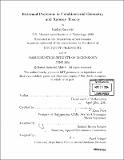| dc.contributor.advisor | János Pach. | en_US |
| dc.contributor.author | RadoiÄ iÄ , RadoÅ¡, 1978- | en_US |
| dc.contributor.other | Massachusetts Institute of Technology. Dept. of Mathematics. | en_US |
| dc.date.accessioned | 2006-03-29T18:27:23Z | |
| dc.date.available | 2006-03-29T18:27:23Z | |
| dc.date.copyright | 2004 | en_US |
| dc.date.issued | 2004 | en_US |
| dc.identifier.uri | http://hdl.handle.net/1721.1/32246 | |
| dc.description | Thesis (Ph. D.)--Massachusetts Institute of Technology, Dept. of Mathematics, 2004. | en_US |
| dc.description | Includes bibliographical references (p. 207-223). | en_US |
| dc.description.abstract | The work presented in this thesis falls under the broad umbrella of combinatorics of Erd's type. We describe diverse facets of interplay between geometry and combinatorics and consider several questions about existence of structures in various combinatorial settings. We make contributions to specific problems in combinatorial geometry, Ramsey theory and graph theory. We first study extremal questions in geometric graph theory, that is, the existence of collections of edges with a specified crossing pattern in drawings of graphs in the plane with sufficiently many edges. Among other results, we prove that any drawing of a graph on n vertices and Cn edges, where C is a sufficiently large constant, contains each of the following crossing patterns: (1) three pairwise crossing edges, (2) two edges that cross and are crossed by k other edges, (3) an edge crossed by four other edges. In the latter, we show that C = 5.5 is the best possible constant, which, through Szekely's method, gives the best known value for a constant in the well known "Crossing Lemma" due to Ajtai, Chvatal, Leighton, Newborn and Szemeredi. After relaxing graph planarity in several ways, we proceed to study ... the maximum number of edges in a drawing of a graph on n vertices without self-crossing copy of C4, the cycle of four vertices. We prove that ... The importance of this and the above mentioned results comes from numerous applications of "Crossing Lemma" and the bounds on ... in discrete and computational geometry (incidence and Gallai-Sylvester type problems, k-set problems, | en_US |
| dc.description.abstract | (cont.) the distinct distances and the unit distance problems of Erd6s, problems on arrangements of circles and pseudo-parabolas, questions on parametric and kinetic minimum spanning trees), number theory, and the VLSI design. Next, we initiate a new trend in Ramsey theory, which can be categorized as the rainbow Ramsey theory. Drawing a parallel with Moztkin's statement that "complete disorder is impossible", we prove the existence of rainbow/hetero-chromatic structures in a colored universe, under certain density conditions on the coloring. Hence, we provide several striking examples supporting the new philosophy that complete disorder is unavoidable as well. In particular, we prove that every 3-coloring of the color classes being equinumerous, contains a rainbow 3-term arithmetic progression. We also consider rainbow counterparts of other classical theorems in Ramsey theory, such as Rado's and Hales-Jewett theorem. Additionally, we refute one geometric strengthening of van der Waerden's theorem, thus, answering an open problem posed by Pach. We continue with two classical problems in Euclidean Ramsey theory: (1) Hadwiger-Nelson problem on the chromatic number of Rd and (2) the empty convex hexagon question of Erd6s. We prove that the chromatic number of R3 is at most 15, improving the previous bound of 18, due to Coulson. Regarding the latter question, which is one of the most notorious open problem in combinatorial geometry, we discover interesting relations on the numbers Xk(P) of empty convex k-gons in an n-element planar point set P ... | en_US |
| dc.description.statementofresponsibility | by RadoÅ¡ RadoiÄić. | en_US |
| dc.format.extent | 223 p. | en_US |
| dc.format.extent | 10549429 bytes | |
| dc.format.extent | 10546048 bytes | |
| dc.format.mimetype | application/pdf | |
| dc.format.mimetype | application/pdf | |
| dc.language.iso | eng | en_US |
| dc.publisher | Massachusetts Institute of Technology | en_US |
| dc.rights | M.I.T. theses are protected by copyright. They may be viewed from this source for any purpose, but reproduction or distribution in any format is prohibited without written permission. See provided URL for inquiries about permission. | en_US |
| dc.rights.uri | http://dspace.mit.edu/handle/1721.1/7582 | |
| dc.subject | Mathematics. | en_US |
| dc.title | Extremal problems in combinatorial geometry and Ramsey theory | en_US |
| dc.type | Thesis | en_US |
| dc.description.degree | Ph.D. | en_US |
| dc.contributor.department | Massachusetts Institute of Technology. Department of Mathematics | |
| dc.identifier.oclc | 56020431 | en_US |
